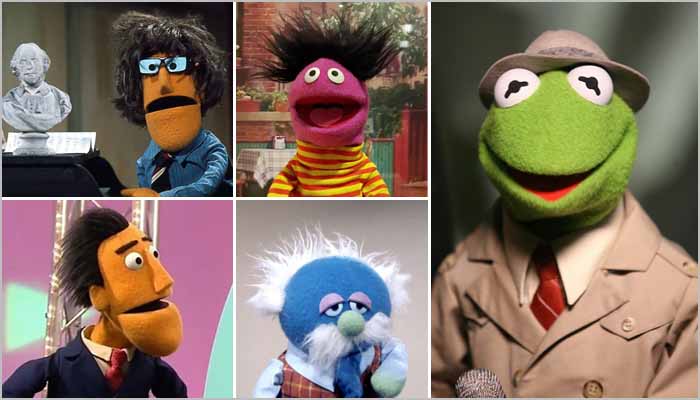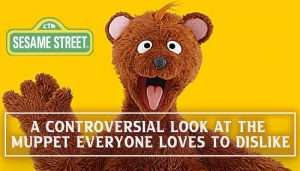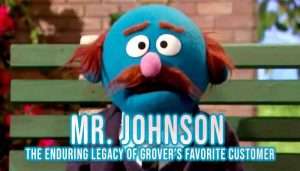For over half a century, Sesame Street has been more than just a television show; it’s been a cultural landmark, a comforting presence in countless childhoods, and a pioneering force in educational media. Generations have grown up learning their ABCs and 123s alongside beloved figures like the eternally optimistic Big Bird, the giggling, furry red monster Elmo, and the voraciously cookie-loving Cookie Monster. From its radical debut in 1969 , conceived as an experiment to harness the power of television for early childhood education, particularly for inner-city children , Sesame Street established itself as a place of learning, laughter, and enduring friendships.
But like any vibrant neighborhood, the population of Sesame Street hasn’t remained static. While the core cast feels timeless, the street has seen residents come and go over its long history. Through the decades, numerous Muppet characters, some fondly remembered, others perhaps faded from memory, have quietly moved away from the familiar stoops and storefronts. This constant evolution reflects the show’s own journey, adapting its format, curriculum, and characters in response to ongoing research, societal shifts, and the practical realities of television production. This exploration takes a nostalgic trip down memory lane, rediscovering some of these “lost” Muppets and uncovering the fascinating, sometimes complex, reasons why their sunny days on Sesame Street came to an end.
The Early Days & Finding the Formula
The Sesame Street that premiered in 1969 was a bold experiment, built on educational goals and extensive research into how children learn. Initially, child psychologists advised producers to keep the human actors and Muppets separate, fearing interaction might confuse young viewers. However, early testing revealed a crucial finding: children’s attention soared during the Muppet segments but dipped during the human-only “Street” scenes. This led to a pivotal change – integrating Muppets like Big Bird and Oscar the Grouch directly with the human cast, creating the dynamic, interwoven format that became the show’s hallmark. This early period of finding the right formula naturally involved some casting adjustments.
One of the most notable early shifts involved perhaps the most famous Muppet of all: Kermit the Frog. Initially, Kermit was a regular presence, often appearing in segments where he’d lecture on letters, numbers, and basic concepts. However, Jim Henson, Kermit’s creator and performer, recognized early on that the frog was destined to be his signature character beyond Sesame Street. Consequently, after the first season, Henson strategically “retired” Kermit from his regular lecturing duties on the show. While Kermit wasn’t gone for good – he returned for the third season and made numerous appearances over the years – his role shifted. Later, external factors also seemed to influence his presence; after Disney acquired The Muppets, Kermit’s appearances on Sesame Street reportedly became rarer, possibly due to rights complexities, with exceptions made for special occasions like an Elmo’s World episode and the 50th Anniversary special. Kermit’s journey illustrates how both internal creative strategies and external business forces can shape a character’s relationship with the Street.
To fill the void left by Kermit’s initial step back, Herbert Birdsfoot arrived in the second season. An accountant-like Muppet, Herbert took over the lecturing role, often assisted by the lovable Grover. Described as nerdy , Herbert represented an early attempt to maintain the educational segment structure. However, his tenure was relatively short-lived; he was phased out by the fifth season, around the time Kermit began appearing more regularly again.
Another early character who didn’t make the long haul was Professor Hastings. Performed by Frank Oz , Hastings was an elderly professor whose lectures on topics like letters (Y and U), numbers (like 2), and comparing objects were notoriously dull – so dull, in fact, that he often fell asleep mid-lecture, a running gag frequently involving Kermit trying to keep the lesson on track. Despite his comedic potential and later popularity in European markets , Professor Hastings was eventually dropped from the show, reportedly because he was considered “too dull”. This decision underscores the show’s fundamental commitment to engaging education; even a character designed around the concept of boredom couldn’t remain if the execution didn’t effectively hold young viewers’ attention, prioritizing the learning experience above all else.
Controversy on the Corner: When Muppets Sparked Debate
Sesame Street was conceived during a time of significant social change, with a specific mission to reach inner-city children and promote racial harmony. Its integrated cast and urban setting were groundbreaking. Despite its gentle and inclusive ethos, the show occasionally found itself navigating controversy, sometimes leading to the departure of Muppet characters.
Perhaps the most prominent and complex example is Roosevelt Franklin. Introduced in 1970, Roosevelt was the show’s first Black Muppet character, created and voiced by Matt Robinson, the actor who also portrayed the original Gordon. Robinson reportedly felt the show needed more content specifically appealing to Black children. Roosevelt was an intelligent character who ran his own school, Roosevelt Franklin Elementary, teaching lessons often through rhyme and scat, covering topics from basic concepts to African geography. He was designed, in part, as a response to early criticism that the show was “too white” , aiming to provide positive Black representation.
However, Roosevelt Franklin’s tenure lasted only until 1975. The primary reason cited for his removal was complaints that the character embodied negative stereotypes of African-American children. Concerns focused on his “rowdy” classroom behavior, which some felt resembled detention , and his use of Black English, which sparked debate about whether it was authentic representation or a harmful caricature.
Crucially, this wasn’t solely a reaction to external pressure from viewers. Significant debate occurred within the Children’s Television Workshop (CTW), the show’s production company. Some Black staff members and advisors expressed concerns. Jane O’Connor, an African-American woman involved in early planning, felt Roosevelt presented a stereotypical view to white children. Others felt the character was “one-dimensional” or reinforced negative images, particularly among “upper-middle class” Black objectors. This internal dissent reveals the complex challenge the show faced in pioneering representation – the very character created to increase Black visibility was ultimately removed due to disagreements over the nature of that visibility. Matt Robinson, Roosevelt’s creator, had aimed to project a positive image and connect with children using familiar language patterns , but the impact was perceived differently by various stakeholders. Shortly after Roosevelt was phased out, Matt Robinson left CTW, suggesting the controversy may have had personal repercussions for the character’s advocate.
Though removed from the show, Roosevelt Franklin wasn’t entirely erased. He continued to appear in Sesame Street books and remains a strong memory for many who grew up in that era. Acknowledging this legacy, he made a brief cameo appearance in the show’s 50th Anniversary Celebration.
While Roosevelt is the most documented case of a Muppet removed due to stereotype concerns based on the available information, other early content decisions also reflect changing sensitivities. The first-season human comedic duo, Buddy and Jim, were described by Time magazine at the time as “a walking Polish joke”. Although their departure was officially attributed to the actors allegedly using scripts without permission, the nature of their humor highlights content that would likely be viewed differently today.
Practical Magic: When Logistics and Life Intervene
Not all Muppet departures stemmed from complex social debates or evolving educational strategies. Sometimes, the reasons were far more practical, rooted in the day-to-day realities of producing a television show and the lives of the performers who bring these characters to life.
Don Music, the perpetually frustrated composer, offers a prime example. Performed by the talented Richard Hunt , Don was known for his creative struggles, often culminating in him banging his head against his piano while crying, “Oh, I’ll never get it right! Never, never, never!”. While intended as comedic hyperbole, this signature action led to his removal. Parents began complaining to the Children’s Television Workshop that their children were imitating Don’s head-banging antics. This reaction highlights the show’s sensitivity to its powerful role in modeling behavior for its young preschool audience and its willingness to make changes based on parental feedback regarding imitable actions. Interestingly, despite the concerns that led to his departure, Don Music remains a fondly remembered character for many adults who grew up watching him. This difference in perspective between parents concerned about immediate imitation and adults looking back with nostalgia is notable. The show itself seemed to acknowledge this enduring affection by including Don Music, performed by Ryan Dillon, in its 50th Anniversary special.
Another departure driven by practicality was that of Bruno the Trashman. This large, full-body Muppet, usually silent, served the specific function of carrying Oscar the Grouch’s trash can, allowing the typically stationary Grouch some mobility. Bruno was created and performed by Caroll Spinney (who also performed Oscar and Big Bird). His origin was purely functional: Spinney needed a way to bring Oscar onto stage during live tours while concealing himself as the puppeteer. Bruno fulfilled this role on the show from 1979 until around 1993. His disappearance wasn’t due to creative decisions or audience reaction, but something far more mundane: the physical Bruno costume simply deteriorated while in storage. Faced with the significant cost of rebuilding the large, complex puppet, the producers opted not to replace him. Bruno’s story serves as a reminder that these beloved characters are also intricate physical objects, subject to the limitations of materials and budgets.
The unavoidable passage of time and changes in the lives of the puppeteers have also significantly impacted the presence of certain characters. The Muppets are unique in the deep, almost symbiotic connection between the puppet and its primary performer. When a key performer passes away or departs, it leaves a profound void. Guy Smiley, “America’s favorite game-show host” , was performed by Jim Henson himself from 1969 until Henson’s final work on the show around 1990. After Henson’s untimely death, Guy Smiley largely vanished from the Street for nearly 15 years. While the character eventually reappeared, performed by Eric Jacobson starting in 2005, his appearances have been relatively infrequent.
Similarly, Forgetful Jones, the amiable cowboy Muppet known for his poor memory, was primarily performed by Richard Hunt from 1981 until Hunt’s death in 1992. Following Hunt’s passing, Forgetful Jones continued to make occasional background appearances but largely ceased having speaking roles for many years. Only recently, starting around 2019, has performer Matt Vogel begun giving Forgetful Jones a voice again in select appearances, including the 50th Anniversary special. These examples demonstrate the immense respect given to the original performers and the challenge of recasting such iconic roles. The decision to reduce a character’s presence or bring them back sparingly after the loss of their original performer reflects the difficulty in capturing that unique magic and the deep bond fans associate between the character and the artist who first brought them to life.
Faded Favorites & Gentle Goodbyes
Beyond the high-profile departures driven by controversy or major practical constraints, numerous other Muppets have gently faded from the regular Sesame Street lineup over the years. These characters often enjoyed periods of popularity but were gradually phased out as the show evolved, new characters were introduced, or their specific segments became less frequent.
Harvey Kneeslapper, the incorrigible prankster performed by Frank Oz, was known for his infectious, knee-slapping laugh. While one source lists him among Muppets “kicked off” the show , specific reasons for his departure aren’t detailed beyond him being phased out after his appearances in the 1970s. Like several other classic characters, he made a welcome, mustachioed cameo in the 50th Anniversary special, performed by Eric Jacobson.
Lefty the Salesman, another Frank Oz original, was the trench-coated, shady character perpetually trying to sell items (often letters or numbers) to an unsuspecting Ernie. A fondly remembered bit player , Lefty seemed to disappear for many years before being recently revived with performer Ryan Dillon.
Sam the Robot, the “Super Automated Machine” whose programming aimed for perfection but often resulted in comical errors, was performed by Jerry Nelson. Mentioned nostalgically by fans , Sam also seems to have been quietly retired from regular duty.
Captain Vegetable, the caped crusader for healthy eating who fought culinary crime with the power of carrots and celery, was initially performed by Jim Henson and later Richard Hunt. Though missed by some viewers , his appearances became sporadic before a return in the 50th special voiced by Peter Linz.
Two beloved Jerry Nelson characters, Sherlock Hemlock and The Amazing Mumford, also saw their roles diminish over time. Sherlock Hemlock, “the world’s greatest detective,” known for his magnifying glass and exclamations of “Egad!” , was a prominent figure in the 70s and 80s but was gradually phased out as newer characters gained prominence. He remains popular in international versions, particularly Germany , and reappeared for the 50th anniversary. The Amazing Mumford, the magician whose magic words were “A la peanut butter sandwiches!” , followed a similar trajectory, fading from regular appearances but returning for the anniversary celebration.
Sometimes, characters disappeared not individually, but as part of larger structural changes. In 1993, Sesame Street expanded its set with a new area called “Around the Corner,” featuring locations like a hotel, jazz club, and thrift store. However, after five years, research revealed that this expanded geography was confusing for young viewers, who struggled with the layout. As a result, the entire “Around the Corner” section was abandoned around 1998. Consequently, all the Muppet characters associated with these locations, such as Benny Rabbit, the cynical bellhop at the Furry Arms Hotel , were retired along with the set itself. This instance clearly demonstrates how formative research directly impacted the show’s physical and narrative structure, prioritizing viewer comprehension above expanding the fictional world.
The recurring pattern of fans expressing fondness for these departed characters and the deliberate inclusion of many—like Don Music, Forgetful Jones, Harvey Kneeslapper, Sherlock Hemlock, Roosevelt Franklin, and Captain Vegetable—in the 50th Anniversary special speaks volumes. It shows that even Muppets absent for decades retain a powerful hold on audience memory and affection, a connection the show’s creators clearly recognize and occasionally celebrate.
A Quick Who’s Who of Vanished Visitors
To provide a quick overview, here’s a summary of some notable Muppets who have left Sesame Street:
| Muppet Name | Approx. Years Active / Key Period | Key Performer(s) | Primary Reason for Departure (Based on Provided Material) |
|---|---|---|---|
| Roosevelt Franklin | 1970-1975 | Matt Robinson | Stereotype Concerns / Controversy |
| Don Music | c. 1970s-1980s | Richard Hunt | Concerns about Imitating Head-Banging |
| Harvey Kneeslapper | c. 1970s | Frank Oz | Phased Out |
| Professor Hastings | Early 1970s | Frank Oz | Deemed “Too Dull” |
| Bruno the Trashman | 1979-1993 | Caroll Spinney | Costume Deteriorated / Replacement Cost |
| Herbert Birdsfoot | c. Season 2-5 | Jerry Nelson? | Phased Out / Kermit’s Return |
| Guy Smiley | 1969-1990 / Sporadic post-2005 | Jim Henson / Eric Jacobson | Performer Death / Limited Recasting |
| Forgetful Jones | c. 1980-1992 / Sporadic post-2019 | Richard Hunt / Matt Vogel | Performer Death / Limited Recasting |
| Lefty the Salesman | c. 1970s / Sporadic post-2019 | Frank Oz / Ryan Dillon | Phased Out / Recently Revived |
| Sam the Robot | c. 1970s | Jerry Nelson | Phased Out |
| Captain Vegetable | c. 1980s / Sporadic post-2019 | J. Henson/R. Hunt/P. Linz | Phased Out / Recently Revived |
| Sherlock Hemlock | c. 1970s-1980s / Sporadic | Jerry Nelson / Matt Vogel | Phased Out / Recently Revived |
| The Amazing Mumford | c. 1970s-1980s / Sporadic | Jerry Nelson / John Kennedy | Phased Out / Recently Revived |
| ‘Around the Corner’ Muppets | 1993-1998 | Various | Associated Set Removed Due to Research |
The Ever-Changing, Always Sunny Street
The story of the Muppets who have disappeared from Sesame Street is a reflection of the show’s own dynamic history. Characters have departed for a multitude of reasons, ranging from complex debates over representation and social impact to practical concerns about child development and imitable behavior. Logistical challenges like costume decay or budget constraints have played a role , as has the profound impact of losing beloved performers like Jim Henson and Richard Hunt. Furthermore, the show’s unwavering commitment to its educational mission, guided by ongoing research into children’s learning and attention, has led to format changes and character adjustments over the decades.
These changes shouldn’t necessarily be viewed as failures, but rather as evidence of Sesame Street‘s remarkable resilience and its dedication to staying relevant and effective for new generations of children. The Street continues to evolve, introducing new residents like Julia, Tango, and the Walker family to address contemporary issues and reflect the diverse experiences of its audience.
Yet, the fondness felt for characters like Roosevelt Franklin, Don Music, Forgetful Jones, and so many others remains undeniable. While they may no longer greet viewers daily, these vanished visitors live on in the cherished memories of those who grew up with them, preserved in vintage clips, storybooks, and the occasional celebratory reunion special. They are part of the rich, ever-expanding tapestry of the most famous street in the world.
Which ‘lost’ Sesame Street Muppet do you miss the most? Share your memories in the comments below!




